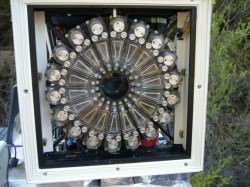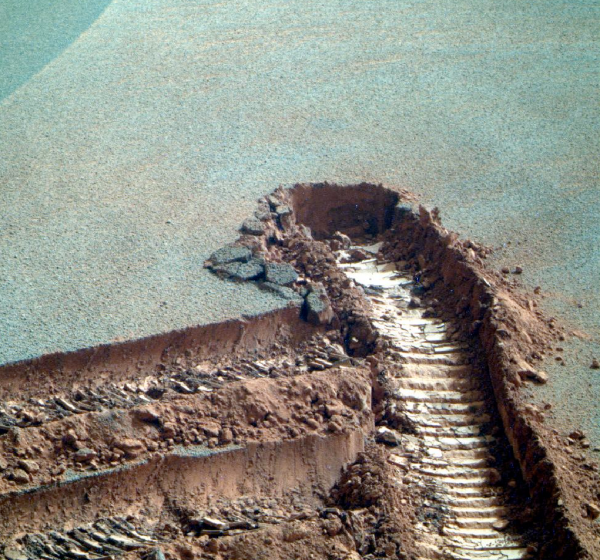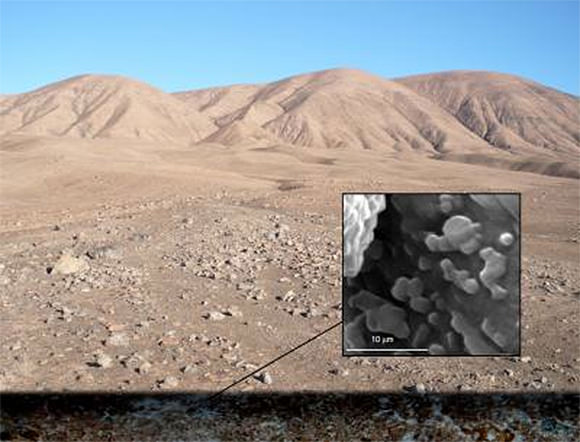[/caption]
Researchers from the Center of Astrobiology (CAB) in Spain and the Catholic University of the North in Chile have found an “oasis” of microorganisms living two meters beneath the arid soil of the Atacama, proving that even on the driest place on Earth, life finds a way.
Chile’s Atacama Desert receives on average less than .01 cm (.004 inches) of rain per year. In some locations rain has not fallen for over 400 years. But even in this harsh environment there is moisture… just enough, at least, for rock salts and other compounds that can absorb any traces of water to support microbial life beneath the surface.
Using a device called SOLID (Signs Of LIfe Detection) developed by CAB, the researchers were able to identify the presence of microorganisms living on thin films of water within the salty subsurface soil.
Even the substrate itself is able to absorb moisture from the air, concentrating it into films only a few microns thick around the salt crystals. This gives the microorganisms everything they need to survive and flourish — two to three meters underground.

At that depth, there is no sunlight and no oxygen, but there is life.
And even when researchers dug to a depth of five meters (a little over 16 feet) and took samples back to a lab, they were able to not only locate microorganisms but also revive them with the addition of a little water.
Of course, the implications for finding life — or at least the remains of its past existence — on Mars is evident. Mars has been shown to have saline deposits in many regions, and the salt is what helps water remain liquid, longer.
“The high concentration of salt has a double effect: it absorbs water between the crystals and lowers the freezing point, so that they can have thin films of water (in brine) at temperatures several degrees below zero, up to minus 20 C,” said Victor Parro, researcher from the Center of Astrobiology (INTA-CSIC, Spain) and coordinator of the study. This is within the temperature range of many regions of Mars, and also anything located several meters below the surface would be well protected from UV radiation from the Sun.
“If there are similar microbes on Mars or remains in similar conditions to the ones we have found in Atacama, we could detect them with instruments like SOLID,” Parro said.
The development of a new version of the SOLID instrument is currently underway for ESA’s ExoMars program.
Read more here on the Science Codex article.



This is ridiculous. If you find microbes on earth, oh well, remember earth is plagued with life. Has nothing to do with Mars.
the article describes the instrument and it’s testing, along with results.
it goes on to describe that it could be used on mars.
what IS ridiculous is that we are left with no clue as to it’s method of operation.
but we have links to follow.
The life in question was detected in an environment that has similarities to that of Mars, therefore it has something to do with Mars. I find it strange that you missed that link.
It would have nothing to with Mars only if, say, it was about life being detected in forests. Or seas.
This discovery helps us determine whether or not we can expect to find life on Mars.
Ok lets say we find these on Mars then what? What does that mean? I dont see the big deal
Everything else alike, the question “are we alone” is millenniums old in various forms. Even today it depends on what you mean with “we”. But a positive finding would verify that abiogenesis (or transpermia) is as easy that it looks here on Earth and tell us more on various forms of “us”.
As an astrobiological student I am partial on the rest, but would add specifically that this would be a big deal for science. As any find it has unforeseen spin offs, but here we would expect that it would help constrain conditions for biospheres and abiogenesis both. The latter would help finding the possible pathways it happened here, which is an interesting open question.
Well it means we’ve found little aliens. The first life outside of Earth. Are we alone : No. Is life common place in the universe : Probably.
That’s generally what it means. No big deal.
I suspect trolling. Nobody with that attitude would even come to this site, let alone read the article and comment on it.
Mirroring zeletic elench plaint, SOLID is using a microarray immunoassay with hundreds of antibodies for detecting various biological compounds. That may be a problem, antibodies doesn’t need to be very specific, but they are still looking for certain substrates to fit to.
If it works well here, what does it tell us of function elsewhere?
At least the title joyed me a little
Numerous fossils have been found on Mars: http://wretchfossil.blogspot.com/
[A lot of trolling today, which is a shame on an important subject.]
No peer-reviewed fossil finds exist.
The question is:
Did the lifeforms originate there, or did an already existing organism from elsewhere simply adapt to this environment?
Life tends to find a way, but getting life in the first place may be a lot more difficult. Still, this does mean that any organisms that developed when Mars was warmer and wetter might have been able to adapt quickly enough to survive. I consider this an important discovery.
Hello Jason! It is the dryest place on the planet. but again like with lake vostock, it’s not a blank slate, there would be life left over from the past billion years living all up in that. Life pops up in places you don’t expect.
Wow, that is really amazing! Now, I maybe thinking that mars is quite related to earth.